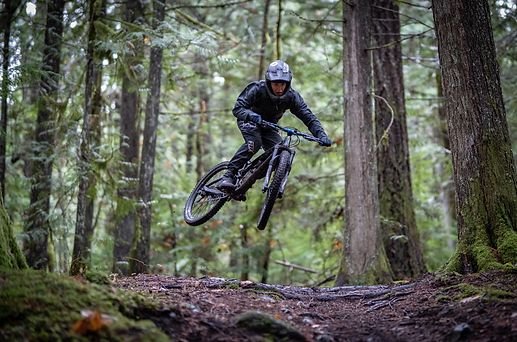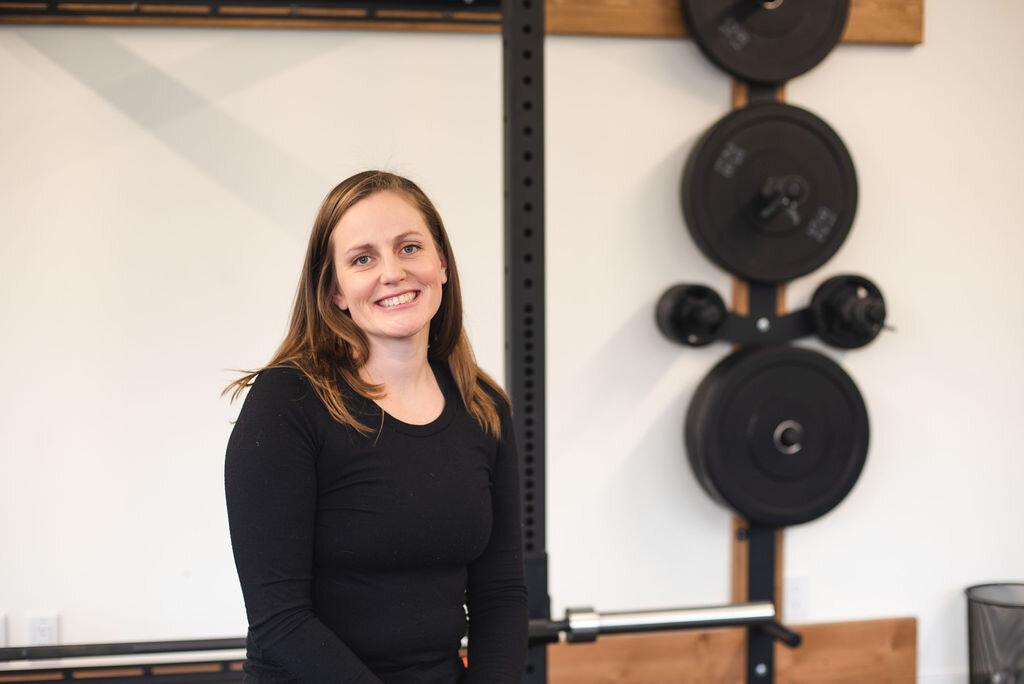It’s that time of year again… spring has sprung, and the snow is quickly giving way to more and more bike trails around Whistler! Now is the perfect time to incorporate some specific strength training exercises into your workout program that will help get you stronger for the mountain bike season ahead. Strength gains made before the season starts leads to better performance (think more power and less fatigue) on the bike as well as reduced injury!
The following exercises focus on movement patterns similar to those performed on the bike such as hinging, squatting, lunging, pushing, pulling and rotating. Let’s take a closer look at these movement patterns on the bike. When in the attack/downhill position - our hips are hinged, our legs are in a split stance position and our upper bodies push down against the handlebars. Riding over technical terrain requires us not only to push but also pull our bikes over features to help us stay balanced. And try going through a turn or switchback without rotating your body... I have done this, and it never ends well!
It is also important to incorporate exercises that will help increase muscular balance throughout the body. Mountain biking is definitely a quad and chest dominant sport and these muscles can become much stronger than their posterior counterparts (i.e., back and hamstrings) leading to muscular imbalances. When muscles are not balanced, the body starts to compensate, becomes inefficient, and overuse injuries can occur. Including exercises that target the weaker muscle groups, such as the back and hamstrings, will help to correct and prevent muscular imbalances, which translates to increased performance and decreased injury risk while riding. More time in the saddle... who doesn’t love that!
Get started with the following six exercises below!
Aim to complete these exercises 2-3x/week, on non-consecutive days. They can be done as set out below or you can incorporate them into your existing resistance training program. Choose a weight that allows you to perform each repetition with control and proper form. The weight should be challenging but doable for the number of repetitions and sets suggested. This means being able to perform about two or three more repetitions max, if you had to, after completing your final rep of each set. I suggest starting with a lighter weight and increasing the load as needed.
The following exercises are laid out in supersets. This means you complete exercises 1A and 1B back to back, then take a 45-60 second rest before completing sets 2 and 3. Do this again for exercises 2A/2B and 3A/3B. Start with 10-15 minutes of dynamic movements (e.g., high knees, marching, walking lunges, body weight squats, down dog to push up, 90/90 hip rotations etc.) to get your body warmed up and ready for the exercises in this workout.
Let me know how you get on with the exercises at tanya@peaktrainingwhistler.com.
Ride hard and ride often… See you on the trails!
SQUATTING
1A. Split Squat (quads & glutes) Perform 3 sets, 8-10 reps per side
This exercise can be performed with body weight, dumbbells or kettlebells.
Stand with your feet hip width apart, brace your core and bring your shoulders down
and back.
Take a moderate step back, keeping your back heel raised and allow your torso to
lean forward slightly.
Most of the weight will be on your front foot - think 75% weight in the front foot and
15% in the ball of the back foot.
As you inhale, lower your hips straight down to load your quads and glutes equally.
Your back knee should be directly under your back hip when lowered down.
Push through the front foot and exhale to come back up.
Remember to keep your torso angled forward slightly the entire movement – think
rib cage stacked over the pelvis and a neutral spine.
PUSHING
1B. Push Up (chest, shoulders & triceps) Perform 3 sets, 8-10 reps
This exercise can be performed on an incline (i.e., wall, counter or barbell at a rack) or at the floor with legs fully extended or on your knees.
Place your hands slightly outside shoulder width apart at chest level and your feet hip width apart.
Hips are in line with your shoulders and there is a neutral curve in your lower back.
Keep your head in line with your spine – think ears in line with shoulders.
Engage your core muscles by bringing your belly button towards your spine and
tightening your abdominals.
Inhale as you bend your elbows to lower your body a few inches aways from the
wall, counter, ground etc.
Engage your chest muscles and push the wall, counter, ground away from you until
your arms are fully extended.
Keep your body aligned and engaged as described above throughout the entire push
up movement.
HINGING
2A. B-Stance Deadlift (hamstrings, glutes & erector spinae) Perform 3 sets, 8-10 reps/side
This exercise can be performed with dumbbells, kettlebells, or a barbell.
Holding a dumbbell or Kettlebell in each hand in front of your thighs or a barbell
with an overhand grip, stand with your feet hip width apart and toes pointing
forward.
Shift your weight into one foot and take a small step back with the other foot so
that your toes are in line with the heel of the front foot.
Lift the heel of your back foot oN the ground, balancing on the ball of your foot.
Most of your weight (about 90%) should be placed in the front foot.
Bring your shoulders down and back and engage your core.
Keeping a soft bend in the front knee, inhale as you hinge forward by pushing
your hips back, lowering the weight to about mid shin.
Keep your back flat, your arms straight and the weight close to your body to
prevent straining the low back.
Exhale and push through your front foot as you bring your hips back up to the
start position.
Rember to keep 90% of the weight in your front foot throughout the entire
movement.
Alternatively, you can hold one dumbbell or kettlebell in the hand opposite the front foot.
PULLING
2B. Bent Row (lats, middle/low traps, rhomboids & posterior deltoids) Perform 3 sets of 8-10reps
This exercise can be performed using dumbbells, kettlebells, or a barbell.
Stand with your feet shoulder width apart, a slight bend in your knees and toes
pointing forward.
Hold a dumbbell or kettlebell in each hand palms facing each other and hands
by your sides or grip a barbell with palms down and hands shoulder width apart.
Engage your core then hinge forward from the hips to about 45 degrees, keeping
your back straight with a slight arch in your lower back, knees slightly bent and
arms straight. Keep your head in line with your spine - ears in line with shoulders.
Inhale, and as you exhale, pull the weight up toward your waist using your back
muscles. Squeeze your shoulder blades at the top of the movement and hold for
1 second.
Inhale as you slowly lower the weight back down with control to the start
position.
LUNGING
3B. Reverse Lunge (glutes, quads, hamstrings & calves) Perform 3 sets, 8-10 reps/side
This exercise can be performed with body weight, dumbbells or kettlebells.
If using, hold a dumbbell or kettlebell in each hand palms facing in.
Stand with your feet hip-width apart, feet facing forward and engage your core
muscles.
As you inhale, step back with one leg, landing on the ball of your foot, and allow both
knees to bend at the same time. Lower your front knee to about 90 degrees. Most of
the weight will be in your front foot.
As you exhale, drive through the front foot and extend your knee as you stand up
fully to the start position.
You can do all reps on one side before switching to the other leg or alternate reps
between each leg.
ROTATING
3. Side Plank with Rotation (obliques, abdominals, deltoids, serratus anterior, hip
abductors)
Perform 2 sets, 8-12 reps/side
This exercise can be performed with legs fully extended or on your knees.
Lie on your right side with your legs straight out and feet stacked on top of each
other, or your legs bent and stacked on top of each other for the bent knee version.
Place your right elbow under your right shoulder with your forearm pointing away
from you and your hand in contact with the floor.
Engage your core and then lift your hips to form a straight line from your head to
feet/knees, hips facing forward. Raise your left arm straight above you towards the
ceiling.
Rotate your upper body towards the floor and thread your left arm underneath your
torso.
Reverse the movement by rotating your upper body and raising your top arm back to
the starting position.
Keep your hips lifted and core muscles engaged for the entire movement.
Ready to ride stronger this season?
Incorporating these movements into your weekly routine will not only help you build the power and endurance you need for mountain biking — it’ll also keep your body balanced, injury-free, and trail-ready.
Got questions? Need guidance? We’re here to support you! Reach out anytime, or better yet — come train with us at Peak and let’s get trail-season ready, together.






































































